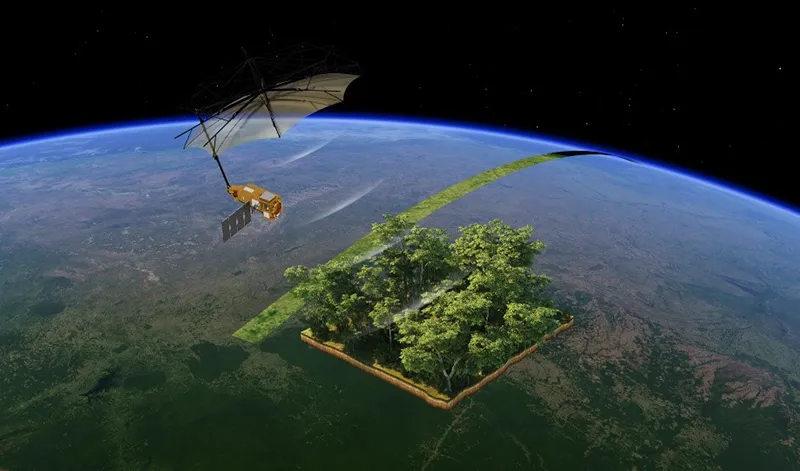A New Satellite Will Map the Carbon Content of Rainforests From Space, and It's Set to Launch This Month
A New Satellite Will Map the Carbon Content of Rainforests From Space, and It’s Set to Launch This Month
The European Space Agency’s new probe, Biomass, will spend five years orbiting the planet and gathering radar imagery of forests across multiple continents
Biomass will monitor the Earth's tropical forests over the next five years.
ESA / ATG medialab under CC-BY-SA 3.0 IGO
After more than ten years of development, the European Space Agency (ESA) is preparing to launch a satellite that will map the carbon content of the world’s rainforests.
The probe, named Biomass, was recently shipped to French Guiana, where it’s slated to lift off from Europe’s Spaceport on April 29 aboard a 230-ton Vega-C rocket. Over the next five years, the spacecraft will orbit the Earth and monitor forests’ above-ground biomass—think trunks and large branches—as well as the height of trees in Africa, Asia and South America. Those measurements, captured with the help of a first-of-its-kind radar, can then serve as a proxy for tracking stored carbon.
“What the mission will do, effectively, is weigh the forests it studies,” says physicist Shaun Quegan, the leader of the Biomass science team, to Robin McKie at the Observer. “We know half that weight must be made up of carbon. So, we are going to be able to weigh the carbon content of the world’s tropical forests from space and, crucially, work out how much these are changing over time.”
“We will then know the balance of carbon that is flowing to and from the atmosphere,” Quegan adds. “That is enormously important.”
Meet Biomass
Watch on
Forests are valuable carbon sinks—they alone sequester a quarter of human-generated carbon emissions annually. But their ability to store carbon is weakening because of deforestation and environmental degradation: A 2020 study led by researchers at the University of Leeds in England found that rainforests could take up one-third less carbon in the 2010s than in the 1990s.
The new probe will allow scientists to understand exactly how carbon levels are fluctuating, teach scientists more about the carbon cycle and map areas of deforestation.
“We need to know the health of our tropical forests,” explains Simonetta Cheli, ESA’s director of earth observation programs, to the Observer. “We need to know the quality and diversity of its vegetation and the amount of carbon stored there. To get that information, we are going to create 3D images of them—from the top of the forest canopy to the roots of its trees.”
Barely any sunlight reaches the floor of a tropical rainforest, but the space-based probe will be able to image all the way to the ground. That’s because it will carry a new P-band synthetic aperture radar, an imaging system that has never been used by a satellite before. The radar signals sent by the instrument can penetrate through dense forest canopies to visualize what’s below.
“By pushing the boundaries of remote sensing, Biomass not only advances our understanding of global forests and carbon cycles but also demonstrates the transformative potential of space-based innovation in tackling Earth’s most pressing environmental challenges,” Cheli adds in a statement.
The Biomass satellite, shown at Airbus in Toulouse, France, before it was shipped to French Guiana
ESA / S. Corvaja
The probe’s capabilities can be transferred to other research areas as well, according to a statement from the ESA. Its radars can be used to observe the structure and motion of ice sheets, for instance, or create models of other areas covered by dense vegetation. In dry areas, it could peer underground.
Scientists hope to use the data from Biomass to create new climate change and carbon cycle models by integrating it with artificial intelligence. “That will tell us what is likely to happen in future,” says Quegan to the Observer. “It will tell us what we are up against.” That information can also help inform policy decisions on forest management and climate mitigation.
Now, engineers have finished fueling the satellite, and they will be making final preparations before its scheduled launch this month.
“It’s marvelous to see the satellite standing proud today, and I wish to thank our industrial partners for all they have done,” Cheli says in a statement. Once Biomass is in orbit, it will collect and deliver “much-needed data to advance Earth science and our understanding of the carbon cycle.”
Get the latest stories in your inbox every weekday.


